Charlotte Harbor
The sound is what woke me. A gurgling sound of rushing
water. Sort of like the being in a washing machine
on the heavy wash cycle. Crawling out of the tiny
cabin into the cockpit I could see in the faint illumination
of the stern light what looked like giant waves bearing
down on our little boat. The night was overcast and
other than the navigational lights in the distance
it was all black. Gary was just sitting in the cockpit
calmly surfing each wave as it passed underneath us.
I crawled up into the cockpit seat and thought, "God
I hope he does not want me to steer".
Seconds later he says "Think I am going to get
a little rest, mind taking over?".
I reply "Sure". After all what else could
I say. He tells me our course, warns me about the
approaching Boca Grande Inlet, then crawls below for
some rest.
At the helm I find that the waves are not nearly
as high as they looked at first. A combination of
the low freeboard of Oaracle, the pitch black overcast
night, and the illumination of the waves by our stern
light had made them into monsters towering over us.
Hours pass without incident. We regularly surf to
over 7 knots as we run downwind.
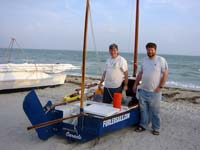 |
Gary and I on
the beach at Fort De Soto the day before the
start of the race. |
My memories of the 2007 WaterTribe Everglades Challenge
are a kaleidoscope of images and events. I will not
describe in detail our voyage as Gary has done a very
good job of that in his article. Instead I will tell
you some stories of my adventure to illustrate what
the Everglades Challenge means to me and what conclusions
I have drawn from it.
Before the Race
The story really begins before the challenge. Earlier
in the year my wife and I interviewed
Steve Isaac AKA Chief of WaterTribe for our Furledsails
Sailing Podcast. I had heard about the WaterTribe
events before, but Chiefs enthusiasm was contagious
and I said on the air that though I did not have time
to get everything together for the 2007 event and
I was planning to participate in 2008.
A few days later I received an email from Gary inviting
me to crew on Oaracle a 20 foot Frollic2
designed by Jim Michalak. He said he had all the gear
and all I would have to get together was food and
clothing. A couple of days later we were in Oaracle
floating around a lake near Gary's home.
The challenge was only a few weeks away so we only
had time for one more sail before leaving. This was
a Saturday that may have been one of the coldest days
all winter. We put in on the St. Marks river and beat
out to the river mouth. The tide was coming in, and
we had a good stiff breeze the entire way. It took
two hours of short tacks to get to the mouth and then
20 minutes to get back to the ramp. This gave me a
good chance to try out my new fleece clothing and
showed me something else. I had been a fair weather
sailor. You know, one of those guys who looks at the
weather forecast for ten minutes before deciding that
it's: too windy, not windy enough, too hot, too cold,
too wet, etc. to go sailing today. Under normal conditions
I would have never gone out on a day like this but
because it was the only day we could go we went out
anyway and it was great. I told Gary that my reluctance
to sail in "imperfect" conditions had prevented
me from having a lot of fun.
 |
The day of the
race: Gary sorts out last minute details. |
Just Before the Race
I rode down to the race start with Chuck (who publishes
Duckworks Magazine), Gary, and Gary's wife Helen.
We set up camp and started talking to all of the other
WaterTribers as they came around. By nightfall there
was a whole bunch there and we ordered some pizza.
I wandered from camp to camp talking about the race,
getting advice, looking at boats. I had a great time.
Everyone was friendly and encouraging. They were without
exception a nice group of people.
I also met Matt Layden the designer of Terrapin,
Swamp Thing, Gjac, Little Cruiser, Paradox, Enigma,
and now a 8 foot long decked pram named Sand Flea.
Sea Flea was nosed up to the shore a few campsites
down and we had wandered down and taken a short look
at her earlier. I had been reading about Matt for
a while. Christy and I had interviewed
Dave and Mindy Bolduc for the podcast and they had
told us a lot about Matt. In addition, a couple of
years before we had both attended the annual West
Coast Trailer Sailor Squadron meet up in Cedar key
but not knowing who he was at the time I had not talked
to him, a situation that had caused me some regret.
So when I saw him walking down the road I jumped up
and introduced myself. I think I may have been a little
to excited when I introduced myself because Matt looked
a little concerned, like he had just met someone crazy
who had just been let out of an institution and was
perhaps not taking all their medication. I can't be
sure that was what he was thinking because Matt was
very polite and gracious. But I did have my suspicions.
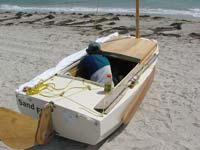 |
Sand Flea and
Matt on the beach before the race. |
When we went to bed the wind was blowing hard from
the south which gave us a little bit of concern, but
the forecast was for it to change to a more northerly
direction as the front came over during the night.
Launch Day or Into the Washing Machine
Within moments of the launch there were people in
real trouble. The wind was coming from the north which
flattened out the water near the beach, but when you
go farther out it was blowing against the tidal flow
causing Tampa Bay to be somewhat lumpy. We saw several
kayakers go over. Most concerning was a kayaker on
a surf ski who went over, got back on and then went
over again. Gary slowed Oaracle down and started going
back and forth to watch and make sure he was o.k.
Nearby I saw Matt stop Sand Flea and just bob up and
down in the chop under perfect control also watching
the events. Another kayaker who did not seem to have
any trouble handling the seas helped the swimming
kayaker back onto his surf sky and then ferried him
over to us so we could tow him back to shore. I reached
out of the cockpit to hold his kayak against the side
of Oaracle and the kayaker held on to our cockpit
coaming. Heading back to the beach I was face to face
with the kayaker and over the five or ten minutes
we towed him his lips slowly turned blue. I asked
him if he was OK, if he was cold, and he said he was
fine. Close to the beach he said "This is good"
and Gary replied "We will get you closer".
This was wise. When we finally let him go he only
stayed on his kayak for less than 20 feet. After he
went over again the kayaker just grabbed his bow and
swam to shore. Gary tacked back and forth waiting
on him to get to the beach and muttered about how
we should have gotten him closer. I was just glad
that we had not let him go further out.
We crossed the bay and went south on the Intracoastal
coastal waterway without further incident. Sometime
along the way Matt took this picture:

The other interactions with kayakers on the first
day were much different. There was a long idyllic
period were we would pass a group of kayakers (including
Kiwibird and Sandybottom) when the wind would pick
up, then be passed by them as it would drop off. The
conversations and company we had during this period
were the most pleasant period of time I had during
the challenge. After check point one when we kept
sailing and the group of kayakers stopped for the
night we never saw them again until they reached the
finish. Makes a big difference when you can take naps
and you don't have to paddle for every foot of progress.
Opening the Bridges
The first bridge we opened called us on the radio
about twenty seconds after the wind was blocked and
Gary started paddling while I steered. The bridge
tender radioed "Are you under power?". Gary
set down the paddle, picked up the radio and said
"We are under sail and oar". Then continued
to paddle. When we passed by her the bridge tender
had an amazed look on her face but still wished us
a nice day.
Just after dark and much further south we were running
from the north downwind towards a bridge that Gary
had talked to on the VHF about opening. They told
us to come, they were opening the bridge. It was dark,
but as we got close we could still see that nothing
was happening with the bridge. I slowed the boat and
continued towards the bridge. Just as I was thinking
we should start making circles before we got to close
to the bumpers, the bridge tender came back on the
radio and said "Oaracle are you the small sailboat
south of the bridge." (remember we were north
of the bridge) with this I threw over the helm and
started turning to port. Shit! There in the darkness
was a kayak with a sail rig only 10 or 20 feet to
our port (well now almost in front of us). I throw
the helm back over and we turn to starboard and circle
a couple of times until the bridge finally opens.
It's a good thing we did not run into Mark. His Kruger
canoe would have been the end of us. Just bits of
shattered plywood and fiberglass floating out to sea.
We may have had three times the weight and size but
Mark makes those canoes and kayaks like battleships.
O.k. perhaps I exaggerate. But Mark did tell me (in
our first
and second
interviews with him) that they are designed and built
to ram a log fully loaded, be levered onto the log
see-saw on the log, then go down the other side without
any damage.
Oh and I swear Mark was in my blind spot!
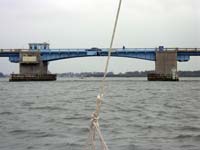 |
One of the many
bridges we passed on the ICW. |
Moon Over the Glades
My most precious time was sailing along the coast
at night and watching the moon rise over the Everglades.
We were running down the coast about two or three
miles offshore right at the edge of the park (I would
see the markers in the moonlight every once in a while).
The stars were out for the first time. Gary was down
below sleeping or just resting and the moon slowly
rose over the Glades and a shimmering road of light
stretched from shore.
The swell was still up and we were surfing, but by
now I had gotten somewhat used to it. I think we were
hitting about 7 knots on the surfs which would last
for 2 or three seconds. A couple of them lasted longer
and after one that must have lasted 8 to 10 seconds
Gary came up from the cabin. On shore we would see
what looked like a cell tower, so Gary tried several
times to call Helen and check in. The signal was so
weak that the flap of his hat was blocking it. But
once he took the hat off he managed to call in.
Wind Sprints in Florida Bay
I had been told that people have walked their boats
through some of the channels in Florida Bay. I am
now very skeptical about this claim. If they did they
are made of much tougher stuff than a mortal man or
have some secret pact with the devil. I pulled Oaracle
about 50 meters and was so tired I just hung on the
bow gasping for Gary to stop pushing. I say if your
not a duck or a wading bird stay in the boat. However
if you ever need to do 3 meter wind sprints I know
just the place.
 |
Gary at the
helm in Florida Bay. |
Race of One
I have come to several conclusions relating to the
racing aspects of the Everglades Challenge. The primary
one is that the competition in the race is in the
most part yourself. The other people provide a good
benchmark to measure yourself against. But there is
to much variation in boats and in conditions to worry
to much about how fast the other people are going.
There is also no reason to race unless you want to.
There is enough pressure from the week schedule to
make it a challenge at a cruising pace.
Leaving the beach at the start of this years race
was an accomplishment all on its own. It took drive,
personal commitment, and planning to get to the beach.
Then it took guts to launch off the beach with the
intention of sailing three hundred miles in a small
boat. I do not look down on those that failed to finish.
Each person had their own situation and should evaluate
their own performance based on that.
Training and Preparation:
The following are some of my thoughts on how to prepare
for doing the Everglades Challenge. If your nowhere
near Florida you could look in your local area for
similar shaped bodies of water. I think that the hardest
navigational / boat handling problems are generally
at the check points and the passes.
Don't let the race start be the first time you have
sailed or paddled your boat. Don't let it be the first
time you have paddled or sailed your boat when it
was raining, choppy, cold, or windy.
Tampa Bay:
There are markers and clear charts, don't stress
it. Sail somewhere close by your house where the ocean
gets lumpy (the Intracoastal coastal on a Saturday?).
Don't plan on passing in front of the container ship
in the main channel. Remember the rule of Gross Tonnage.
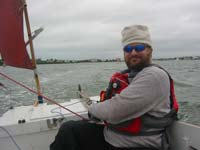 |
Here I am at
the helm somewhere near Venice. |
Check Point One:
If you were to put in around Venice you would have
about 20 nm to Grande Tours. You could go out a pass
then back in on the way, then you could row your boat
up to check point one. If you did the down the sails,
out with the oars, then down with the mast drill in
the dark it would be even more realistic, because
it is almost certainly going to be dark when you get
there on race day. (note there is a 7 sq foot "beach"
to the right of the bridge going inland that you can
stick your bow on while you take down the mast.
A shorter version of this would be to drive to Grande
Tours rent a kayak or put your own boat in and go
in and out of the channel a couple of times (seeing
how it looks in the dark would be good to).
Check Point Two:
Sail from Everglades city or Chokoloskee in and out
of Indian Pass, between Indian Pass and Chokoloskee
and out the Chokoloskee Pass or the other pass (rabbit?)
to the Pavilion Key area. If you're going inside the
Everglades paddle down the trail for a while.
Check Point Three:
Flamingo is not really hard to navigate see the next
one
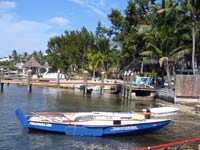 |
Oaracle
at the finish line on Key Largo. |
Florida Bay:
If you have never been on it, your either way smarter
than I am or you don't really understand what it is
like. I thought it was a bay before we got there.
Forget bay; think swamp without many trees. Just a
swampy muddy area with creeks flowing through it and
a few ponds. Sail between Key Largo finish and Flamingo
and back with no motor. You will be fine come the
race. Use your motor and you will still be better
off than if you have never been there. (Take way points)
Enjoy, it is beautiful.
Once when you run aground in the mud get out and
sink to your knees (or higher) push the boat 3 yards,
catch your breath climb in boat, lay down, take your
heart meds, then vow to never ever get out of the
boat again. (I heard a rumor that someone trained
for FL bay by sprinting through the mud pushing their
boat - perhaps but are You an Olympic class athlete?
Roo used a set of boards as stepping places to move
his boat. I have been thinking poles might work well.
I have seen rowing work. Unless you are amazingly
lucky you will not be able to sail the entire distance,
but you should not have to row very far.
The power boats often cannot stop, if they came off
plane they would go aground. Shallow water at its
best.
Noel
PS: I just finished reading the current edition
of Small Craft Advisor. There is a full page advertisement
for Watertribe. It says: "A life-changing experience".
All I can say to that is yes.

|